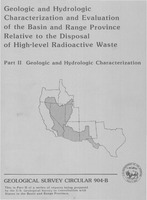Geologic and hydrologic characterization and evaluation of the Basin and Range Province relative to the disposal of high-level radioactive waste: Part II, Geologic and hydrologic characterization
Links
- Document: Report (pdf)
- Related Works:
- Circular 904-A Part I, Introduction and guidelines
- Circular 904-C Part III, Geologic and hydrologic evaluation
- Superseded Publications:
- Download citation as: RIS | Dublin Core
Abstract
The geology and hydrology of the Basin and Range Province of the western conterminous United States are characterized in a series of data sets depicted in maps compiled for evaluation of prospective areas for further study of geohydrologic environments for isolation of high-level radioactive waste. The data sets include: (1) Average precipitation and evaporation; (2) surface distribution of selected rock types; (3) tectonic conditions; and (4) surface- and ground -water hydrology and Pleistocene lakes and marshes.
Rocks mapped for consideration as potential host media for the isolation of high-level radioactive waste are widespread and include argillaceous rocks, granitic rocks, tuffaceous rocks, mafic extrusive rocks, evaporites, and laharic breccias. The unsaturated zone, where probably as thick as 150 meters (500 feet), was mapped for consideration as an environment for isolation of high-level waste. Unsaturated rocks of various lithologic types are widespread in the Province.
Tectonic stability in the Quaternary Period is considered the key to assessing the probability of future tectonism with regard to high-level radioactive waste disposal. Tectonic conditions are characterized on the basis of the seismic record, heat-flow measurements, the occurrence of Quaternary faults, vertical crustal movement, and volcanic features. Tectonic activity, as indicated by seismicity, is greatest in areas bordering the western margin of the Province in Nevada and southern California, the eastern margin of the Province bordering the Wasatch Mountains in Utah and in parts of the Rio Grande valley. Late Cenozoic volcanic activity is widespread, being greatest bordering the Sierra Nevada in California and Oregon, and bordering the Wasatch Mountains in southern Utah and Idaho.
he arid to semiarid climate of the Province results in few perennial streams and lakes. A large part of the surface drainage is interior and the many closed basins commonly are occupied by playas or dry lake beds. The Province is divided into ground-water flow units defined on the basis of ground-water divides, ground-water flow lines, and surface streams that receive ground-water discharge.
Ground water contains less than 500 milligrams per liter of dissolved solids throughout most of the Province. Ground water is more mineralized in areas underlain by evaporitic rocks, overlain by playas, and near saline lakes. Ground water is of the calcium, magnesium, or sodium bicarbonate type in the areas where dissolved-solids concentrations are less than 500 milligrams per liter, and of the calcium, magnesium, or sodium sulfate or chloride type where dissolved-solids concentrations are greater than 500 milligrams per liter.
Geologic and hydrologic evidence is found for about 100 lakes and marshes that existed during the Pleistocene Epoch. The possibility of a recurrence of pluvial conditions, such as existed in the Pleistocene, is of concern in repository siting because of possible changes in hydrologic conditions. The Pleistocene lakes and marshes provide clues to the hydrology during pluvial climates.
Study Area
| Publication type | Report |
|---|---|
| Publication Subtype | USGS Numbered Series |
| Title | Geologic and hydrologic characterization and evaluation of the Basin and Range Province relative to the disposal of high-level radioactive waste: Part II, Geologic and hydrologic characterization |
| Series title | Circular |
| Series number | 904 |
| Chapter | B |
| DOI | 10.3133/cir904B |
| Year Published | 1985 |
| Language | English |
| Publisher | U.S. Government Printing Office |
| Publisher location | Washington, D.C. |
| Contributing office(s) | Utah Water Science Center |
| Description | iv, 30 p. |
| Public Comments | This is Part II of a series of reports being prepared by the U.S. Geological Survey in consultation with States in the Basin and Range Province. |
| Country | United States |
| State | Arizona, California, Idaho, Nevada, New Mexico, Oregon, Texas |
| Other Geospatial | Basin and Range Province |


